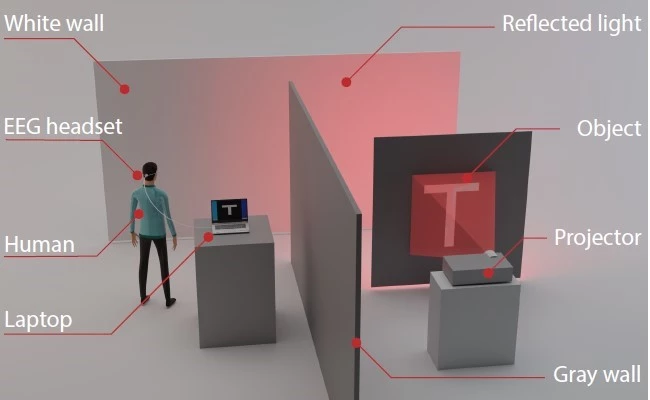X-ray vision has long been a staple power for superheroes, but soon mere mortals could see hidden objects with a little help from AI. Researchers at the University of Glasgow have demonstrated a “ghost imaging” system that reads the brainwaves of a person looking at light scattered off a wall to identify an object around a corner.
The new breakthrough is part of an emerging branch of technology known as non-line-of-sight (NLoS) imaging, which allows the viewing of objects obscured by obstacles. Sometimes, it involves beaming laser light onto a surface, around a corner and back to a camera sensor, then using algorithms to decode the scattered returned light to identify the object. For the new study, the researchers swapped out the camera for human eyes.
The experiment was set up so that the hidden object was made up of light patterns from a projector cast onto a cardboard cut-out. From around the corner, the human participant could only see diffused light on a white wall, which alone wouldn’t be clear enough to make out the original object. But that’s where the AI component comes in.
The human subjects wore an EEG helmet, which was able to read signals in their visual cortex. These signals were fed into a laptop running AI algorithms which could then decode the scattered light and identify the object. The strength of the EEG signal roughly correlated with the intensity of light on different areas of the wall, so the algorithm was able to use this to “carve” the correct image out of the diffused light.

In tests, each “object” was a 16 x 16-pixel image, with the light patterns flickered at a frequency of 6 Hz for two seconds. And sure enough, after about a minute of observation of the light, the system was able to accurately reconstruct each object.
“This is one of the first times that computational imaging has been performed by using the human visual system in a neurofeedback loop that adjusts the imaging process in real time,” said Daniele Faccio, lead researcher on the project. “Although we could have used a standard detector in place of the human brain to detect the diffuse signals from the wall, we wanted to explore methods that might one day be used to augment human capabilities.”
The researchers say that future work will investigate imaging objects in three dimensions, and combining data from multiple viewers at the same time.
The research will be presented at the Optica Imaging and Applied Optics Congress in July.
Source: Optica




